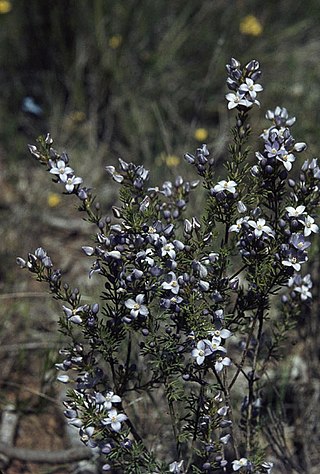
Banksia nobilis, commonly known as the golden dryandra, great dryandra or kerosene bush, is a shrub of the family Proteaceae which is endemic to Western Australia. It occurs on lateritic rises from Eneabba to Katanning in the state's Southwest Botanic Province. With large pinnatifid leaves with triangular lobes, and a golden or reddish pink inflorescence, it is a popular garden plant. It was known as Dryandra nobilis until 2007, when all Dryandra species were transferred to Banksia by Austin Mast and Kevin Thiele. There are two subspecies, B. nobilis subsp. nobilis and B. nobilis subsp. fragrans.

Banksia proteoides, commonly known as king dryandra, is a shrub endemic to Western Australia. It was known as Dryandra proteoides until 2007, when all Dryandra species were transferred to Banksia by Austin Mast and Kevin Thiele.

Banksia stuposa is a species of shrub that is endemic to the southwest of Western Australia. It has hairy stems, broadly linear pinnatifid leaves, golden yellow and white flowers in heads of one hundred or more, and hairy, egg-shaped follicles.
Conospermum acerosum, commonly known as needle-leaved smokebush, is a shrub endemic to Western Australia
Conospermum glumaceum, commonly known as hooded smokebush, is a shrub endemic to Western Australia.
Conospermum stoechadis subsp. sclerophyllum is a shrub endemic to Western Australia.

Conospermum incurvum, commonly known as plume smokebush, is a shrub endemic to Western Australia.

Stirlingia simplex is a plant endemic to Western Australia.

Amyema quandang is a species of hemi-parasitic shrub which is widespread throughout the mainland of Australia, especially arid inland regions, sometimes referred to as the grey mistletoe.

Asteridea is a genus of flowering plants in the family Asteraceae. Evidence suggests that the genus, Asteridea, is monophyletic.

Adenanthos barbiger, the hairy jugflower or hairy glandflower, is a species of shrub in the family Proteaceae. It is endemic to the south-west of Western Australia. It usually grows to 1 metre high, and has bright red flowers that appear mostly between August and December. The species was first formally described in 1839 by English botanist John Lindley in A sketch of the vegetation of the Swan River colony.

Scaevola platyphylla, commonly known as broad-leaved fanflower, is a shrub in the family Goodeniaceae. It is endemic to the south-west of Western Australia. Plants grow to between 0.3 and 1.3 metres high and have blue to purple flowers that appear between August and January in their native range.

Haemodorum is a genus of herbs in the family Haemodoraceae, first described as a genus in 1798 by James Edward Smiith. The genus is native to New Guinea and Australia. The type species is Haemodorum corymbosum Vahl, first described by Martin Vahl in 1805.

Conothamnus is a genus of flowering plants in the family Myrtaceae and is endemic to the south-west of Western Australia. They are woody shrubs similar to melaleucas but differ in that their leaves are usually arranged in opposite pairs and the maximum number of seeds per fruit is three.

Johnsonia pubescens, commonly called the pipe lily, is a grass-like plant in the family Asphodelaceae, subfamily Hemerocallidoideae, endemic to the south-west of Western Australia. As with others in the genus, it is distinguished by its minute flowers which are on the end of a spike and hidden by large, overlapping, papery bracts.

Cyanothamnus ramosus is a species of plant in the citrus family Rutaceae and is endemic to the southwest of Western Australia. It is an erect, mostly glabrous shrub with pinnate leaves with up to seven leaflets, and white, four-petalled flowers with blue or pale green backs.

Pithocarpa pulchella is an erect, rigid, perennial herb in the Asteraceae family, which is endemic to the south-west of Western Australia.

Asteridea pulverulenta is a species of flowering plant in the Asteraceae family, which is endemic to Western Australia, in the south-west. It was first described in 1839 by John Lindley.

Hybanthus floribundus is a plant in the Violaceae family, found in southern Western Australia, southern South Australia, Victoria and southern New South Wales.

Haemodorum laxum is a plant in the Haemodoraceae family, native to Western Australia, and was first described by Robert Brown in 1810.

















